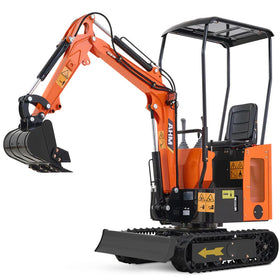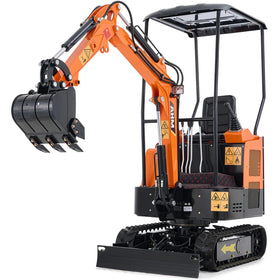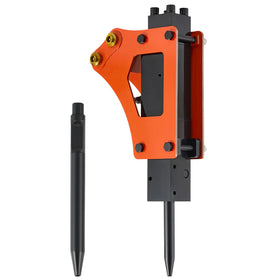The hydraulic system is the beating heart of your mini excavator, powering everything from digging and lifting to swiveling and turning. Understanding how it works, how to troubleshoot issues, and ways to upgrade it can significantly improve your machine’s performance and longevity. In this guide, we’ll cover identification, functionality, troubleshooting, and upgrades to keep your hydraulic system running smoothly.
(Reading Time: 5-8 Minutes)
What Is the Hydraulic System and How Does It Work?
The hydraulic system uses pressurized fluid to transfer energy, enabling your excavator to perform heavy-duty tasks. Let’s break it down:
Hydraulic Tank:
- Location: Typically housed in the engine compartment.

- Function:
- Stores hydraulic fluid.
- Absorbs heat to prevent overheating.
- Acts as a reservoir for fluid displaced during cylinder movement.
- Key Component: Many tanks feature a combination temperature and fluid level gauge. Keep an eye on this—overheating hydraulic fluid (above 140°F) dramatically reduces its lifespan and increases system wear.

Hydraulic Pump:
- Type: Positive displacement pump (commonly gear-driven).
- Operation: Moves fluid from the tank to the directional control valves (DCVs) and other components. The pump maintains a constant flow regardless of the load.
Directional Control Valves (DCVs):
- Purpose: Direct fluid to specific functions, such as lifting, digging, or turning.
- Open vs. Closed Center: Mini excavators typically use closed-center DCVs, meaning fluid doesn’t flow through the system unless a lever is engaged.
Pressure Relief Valve:
- Protects the pump and other components by releasing excess pressure back to the tank.
- Proper pressure settings are critical for optimal performance.

Common Hydraulic System Issues and Troubleshooting
Even the best systems can encounter problems. Here’s how to diagnose and address common hydraulic issues:
1. Low Power or Sluggish Performance
- Possible Causes:
- Incorrect pressure relief valve settings.
- A worn hydraulic pump.
- Blocked or restricted hoses.
- Solution:
- Test system pressure using a hydraulic gauge (connect to a spare port like the third-function hookup).
- Compare the reading to your machine’s manual specifications and adjust the relief valve if necessary.

2. Overheating Fluid
- Possible Causes:
- Continuous heavy use.
- Lack of a hydraulic oil cooler.
- Solution:
- Add a cooler or inspect existing cooling components for blockages.
- Ensure fluid levels are correct, as low levels increase heat generation.
3. Leaks or Contamination
- Possible Causes:
- Worn seals or cracked hoses.
- Contaminants in the hydraulic fluid.
- Solution:
- Regularly inspect hoses and seals for damage.
- Replace hydraulic fluid and filters periodically to maintain cleanliness.
Hydraulic System Upgrades for Better Performance
Upgrading your mini excavator’s hydraulic system can enhance efficiency and extend the machine’s lifespan.
1. Adding a Hydraulic Filter
- Benefit: Removes contaminants from the fluid, reducing wear on the pump and valves.
- Installation Tip: Place the filter in the return line or in the engine bay for easy maintenance.
2. Installing a Hydraulic Oil Cooler
- Benefit: Prevents overheating, especially during prolonged or heavy-duty use.
- Installation Tip: Use an area with adequate airflow, such as the engine bay, and pair the cooler with a fan for optimal heat dissipation.

3. Pressure Relief Valve Adjustment
- Benefit: Ensures the system operates at the correct pressure, maximizing power while protecting components.
- Adjustment Steps:
- Connect a hydraulic gauge to an unused port.
- Run the machine at full throttle and actuate the relevant function.
- Adjust the relief valve until the pressure matches the manufacturer’s recommendation.
It’s worth noting that the AHM AX-15 mini excavator is an excellent example of a machine with a highly efficient and durable hydraulic system. Its design prioritizes both performance and longevity, giving operators confidence in tackling any task.
Tips for Maintaining Your Hydraulic System
- Monitor Fluid Levels and Temperature: Check the tank gauge regularly to prevent overheating and maintain optimal fluid levels.
- Inspect Components Frequently: Look for leaks, worn seals, or damaged hoses during routine maintenance.
- Replace Fluid and Filters on Schedule: Dirty fluid is the enemy of hydraulic systems. Stick to the manufacturer’s recommended maintenance intervals.
- Use Quality Hydraulic Fluid: Always use fluid that meets or exceeds the specifications in your owner’s manual.
Conclusion
Your excavator’s hydraulic system is vital to its performance and reliability. By understanding how it works, addressing potential issues early, and exploring smart upgrades, you can ensure it operates at peak efficiency for years to come.
With AHM, you not only get top-notch quality excavators like the AX-15 but also access to dedicated U.S.-based technical and customer service support. Upgrade your equipment with confidence and experience the difference AHM brings to your projects. Whether you’re tackling tough digging jobs or precision tasks, AHM is your trusted partner in success.
Frequently Asked Questions
What are the key components of a mini excavator’s hydraulic system?
The hydraulic system mainly includes the hydraulic oil tank, hydraulic pump, directional control valves (DCV), and pressure relief valves. These components work together to transfer energy and power the excavator’s movements such as digging, lifting, and rotating.
How can I tell if the hydraulic system is losing performance or power?
Common signs include slow or weak mechanical movements, which may be caused by worn hydraulic pumps, incorrect pressure relief valve settings, or blocked hoses. Using a hydraulic pressure gauge to measure system pressure and comparing it with manufacturer specs helps diagnose issues.
What happens if the hydraulic oil overheats and how can I prevent it?
Hydraulic oil temperatures above approximately 140°F accelerate oil degradation and damage system components. Prevent overheating by regularly checking oil levels and temperature, installing a hydraulic oil cooler if needed, and ensuring the cooling system is functioning properly.
How should I handle hydraulic leaks or oil contamination?
Inspect hoses and seals for wear or damage and replace any faulty parts immediately. Regularly change hydraulic oil and filters to keep the system clean, which extends the life of the hydraulic components.
How do I adjust the hydraulic pressure relief valve?
Attach a hydraulic pressure gauge to the test port, run the engine at full RPM, and activate the relevant function. Adjust the relief valve according to the pressure specifications in the equipment’s manual to ensure optimal pressure that protects the system and maintains performance.
What upgrades can improve the hydraulic system’s performance on a mini excavator?
Common upgrades include installing high-efficiency hydraulic filters to reduce contamination, adding an oil cooler to prevent overheating, and fine-tuning the pressure relief valve for stable system operation.
What should I do if the hydraulic system produces unusual noises?
Abnormal noises may indicate internal pump wear or air trapped in the system. Check for sufficient, clean oil and bleed any air from the system. If noise persists, consult a professional technician for pump inspection.







